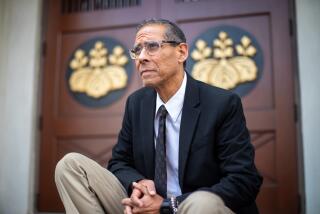From the Archives: Man wrongfully convicted in motherâs 1983 slaying, jurist says
A San Fernando Valley man serving a life sentence in state prison for the 1983 beating and stabbing death of his mother was wrongfully convicted and should be retried or set free, a federal magistrate judge in Los Angeles has recommended.
In a 69-page report, U.S. Magistrate Judge Ralph Zarefsky concluded that key evidence prosecutors used to convict Bruce Lisker -- including a bloody shoe print left at the murder scene -- was âfalse evidenceâ that did not incriminate him.
Furthermore, Zarefsky found that Liskerâs defense lawyer -- now a Superior Court commissioner -- performed so poorly in the case that Lisker, who is 43, was deprived of his constitutional right to effective assistance of counsel.
Zarefskyâs report, released late Monday, mirrors findings of a seven-month Times investigation published in 2005, which undermined key elements of the prosecutionâs case against Lisker and exposed the LAPDâs investigation into the slaying of his 66-year-old mother, Dorka, as sloppy and incomplete.
Despite the legal victory, Liskerâs release from prison remains uncertain. Zarefskyâs report has been forwarded to a U.S. District Court judge, who can adopt the document as written, make changes or reject it altogether. Prosecutors may also appeal rulings that donât go their way. A retrial, however, seems unlikely because new evidence has undermined the prosecutionâs case against Lisker and key witnesses have either died or been discredited.
Liskerâs private investigator, who has worked on the case more than a decade, said he spoke to his client Monday night and told him the news.
âHe was thrilled,â said Paul Ingels. âHe was in tears. We discussed what a long haul itâs been. We used to say there was light at the end of the tunnel. Now he feels like heâs finally going to get out of the tunnel.â
Scott Gerber, a spokesman for the state attorney generalâs office, which is defending Liskerâs conviction, said lawyers were âcarefully reviewingâ the magistrateâs opinion and were âevaluating all of our options.â
âReasonable doubtâ
Retired Deputy Dist. Atty. Phillip Rabichow, the prosecutor who won Liskerâs conviction, said in an interview Tuesday that he was not convinced of Liskerâs innocence but that he believed there was insufficient evidence to retry the case.
âThe bottom line is that I have reasonable doubt as to his guilt,â Rabichow said.
In his ruling, Zarefsky took a swipe at lawyers from the attorney generalâs office, suggesting that they caused a yearlong delay in addressing the merits of Liskerâs petition with needless legal maneuvers. Liskerâs attorneys have said they might make a motion to have their client released on bail if the attorney generalâs office seeks an appeal or any further delays in the case.
Lisker was arrested on suspicion of killing his mother March 10, 1983. He was 17 at the time and, because of drug use and frequent arguments with his mother, was living in a nearby apartment paid for by his parents.
He told police he went to the family home in Sherman Oaks the day of the slaying and knocked on the door. His mother didnât answer. After a few minutes he became concerned and walked around to the backyard to look through the living room window and patio sliding glass door. He said that he thought he could see his motherâs feet from the living room window and that he could definitely see her head through the sliding glass door. She appeared to be lying on the floor in the entry hall.
Lisker told police he broke in through a kitchen window and found his mother bloody and unconscious, with two knives protruding from her back. He said he removed the knives and called paramedics. His mother was taken to the hospital and died a short time later.
Andrew Monsue, the lead detective on the case, was immediately suspicious of Liskerâs account. He didnât believe that the frizzy-haired teen dressed in a Led Zeppelin T-shirt could have seen his mother through the rear windows of the house as he claimed. Monsue thought that his view through the living room window would have been blocked by reflection from the late-morning sun and that a fireplace and brick planter would have blocked his view of his motherâs head.
This became the foundation of the prosecutionâs argument at trial -- that Lisker was lying about being able to see his mother, and that if he was lying about that, he was lying about everything else. Rabichow, the prosecutor, also sought to undermine Liskerâs claim that someone else had committed the crime. Rabichow told jurors that there were several bloody footprints left at the scene and that they all belonged to Lisker.
But at an evidentiary hearing in 2005, Zarefsky heard undisputed evidence that none of the bloody prints matched Liskerâs shoes. There was also testimony that an apparent shoe impression on the victimâs head did not match Liskerâs shoes, but was similar in âsize and dimensionâ to a bloody shoe print left in the bathroom of the home.
The evidentiary hearing also found that Lisker could have seen his mother from the windows at the back of the house. In his ruling, Zarefsky noted that Rabichow -- as a result of The Timesâ investigation -- had since testified that his argument to the jury on that point had been wrong.
âWhen he returned to complete a reconstruction of the scene in 2005 with two reporters from the Los Angeles Times, prosecutor Rabichow was surprised to discover that he could see from outside the dining room door a person lying in the position in which he had argued the victim had been lying.â
Experts for both Lisker and the attorney general confirmed that Lisker could have seen his mother from the back of the house as he claimed. Zarefsky said weather reports from the day of the slaying also showed that conditions were overcast, meaning that there would not have been much glare on the window impeding Liskerâs view.
Lawyer criticized
Zarefsky criticized Liskerâs attorney, Dennis E. Mulcahy, for not conducting a more thorough investigation into the evidence or more vigorously pursuing a theory that one of Liskerâs friends committed the crime. That alternative suspect was Mike Ryan.
Shortly after his arrest, Lisker wrote to Det. Monsue that he should look into Ryan as a potential suspect. Lisker said heâd heard from his father that Ryan, a habitual runaway with a drug problem and lengthy criminal record as a juvenile, had visited the Lisker house the day before the murder.
Monsue would later learn that Ryan arrived in Los Angeles just days before the killing and left town the next day. The detective tracked Ryan down in Mississippi, where he was in juvenile hall for attempting to break into a womanâs house. Ryan acknowledged having gone to the Lisker home looking for work the day before the slaying but said Dorka turned him away.
Ryan told the detective that heâd checked into a motel in Hollywood at 11 a.m., just about the time authorities believe Dorka was being killed.
Monsue confronted Ryan, saying the motelâs registration book showed he didnât check in until four hours later, at 3 p.m. Ryan told Monsue that heâd been in a knife fight on the day of the murder. He said he checked into the motel under an alias because he was scared after having been in the fight -- an explanation that didnât make sense because heâd already checked in under the alias before the alleged fight occurred.
Despite facts potentially linking Ryan to the crime, Monsue dismissed him after running his criminal record, which came up clean. But Monsue used the wrong date of birth when checking Ryanâs record. A search with the correct date would have revealed that Ryan had been convicted of robbing a teenager at knifepoint 10 months before Dorka Lisker was killed.
In 1986 Ryan attacked a woman with a knife in San Francisco and was sentenced to six years in prison. He committed suicide in 1996.
The jury that decided Liskerâs fate in 1985 never heard about Ryan. Mulcahy, Liskerâs lawyer, tried to persuade Judge Richard G. Kolostian to let him present a defense depicting Ryan as an alternative suspect, but the judge wouldnât allow it.
According to Zarefskyâs review of the case, Mulcahy failed to cite the most convincing evidence he had linking Ryan to the crime. For example, he didnât tell Kolostian about the false alibi Ryan had given the police, his use of an alias or the alleged knife fight.
âBy his failure to inform the trial court of the exculpatory evidence in his possession, Mulcahy lost his only opportunity to present the jury with a credible argument that someone other than [Lisker] committed the murder,â Zarefsky wrote.
Another crucial piece of evidence missed by Mulcahy was a phone bill showing that a call to a number nearly identical to Ryanâs motherâs was placed from the Lisker home around the time of the slaying.
Zarefsky acknowledged that the standard for making a finding of ineffective assistance of counsel was strict, but said that even when giving Mulcahy the benefit of the doubt, âhis performance was inexplicable.â
Mulcahy did not return a call seeking comment.
William Genego, one of Liskerâs attorneys, said Zarefskyâs recommendations were a milestone in Liskerâs quest for freedom.
âThe opinion makes you want to cheer and cry,â Genego said. âCheer, because it is a vindication of what Bruce has been saying for all these years, and cry, because it shows how the state has been able to keep him in prison for 26 years based on what the magistrate has found to be false evidence.â
More to Read
Sign up for Essential California
The most important California stories and recommendations in your inbox every morning.
You may occasionally receive promotional content from the Los Angeles Times.











